Prostate Cancer Treatment in New Delhi, India
Complete information about the best Prostate Cancer treatment in New Delhi, India
- What is prostate cancer?
- What are risk factors for prostate cancer?
- What are the signs of prostate cancer?
- How to diagnose prostate cancer?
- What is the staging and grading of prostate cancer?
- What is the treatment for early prostate cancer?
- What is Hormone therapy for prostate cancer?
- What are the complications of prostate cancer treatment?
- Lifestyle management in prostate cancer treatment?
- What questions you should ask your doctor in prostate cancer treatment?
- Why choose Dr ashish sabharwal for prostate cancer treatment?
- Which Is The Best Prostate Cancer Treatment?
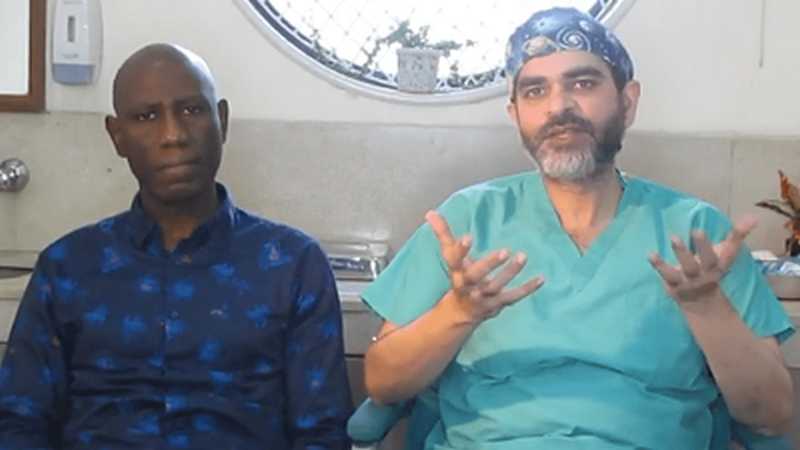
Ben* was diagnosed with prostate cancer just two days after his 55th birthday. He had no symptoms but on routine testing his PSA was 12, quite high! “At that point my urologist did a prostate biopsy which confirmed I was having Prostate Cancer! “
Due to his young age and his wish to be cancer free, he chose to undergo robotic radical prostatectomy. He was discharged on the third Post-operative day. He hardly had any pain. His catheter was removed after 10 days and he does not have any urine leakage.
His cancer has been cured and he is now a prostate cancer winner!!
*the patient’s name has been changed.
Introduction of Prostate Cancer Disease:
Prostate cancer is the most common cancer in men. The incidence of prostate cancer in Indian men is about one patient in every 20 to 25 men. If prostate cancer is diagnosed at an early stage it can be totally cured.
The survival rates of prostate cancer have increased nowadays, thanks to the better testing and treatment options.
Some of the prostate cancers are slow-growing and no treatment is needed for them and others grow very fast and are life threatening.
To make a decision regarding the treatment that’s best for your family or loved ones, can be tough. Consult Dr Ashish Sabharwal today, to help make the right choice for you.
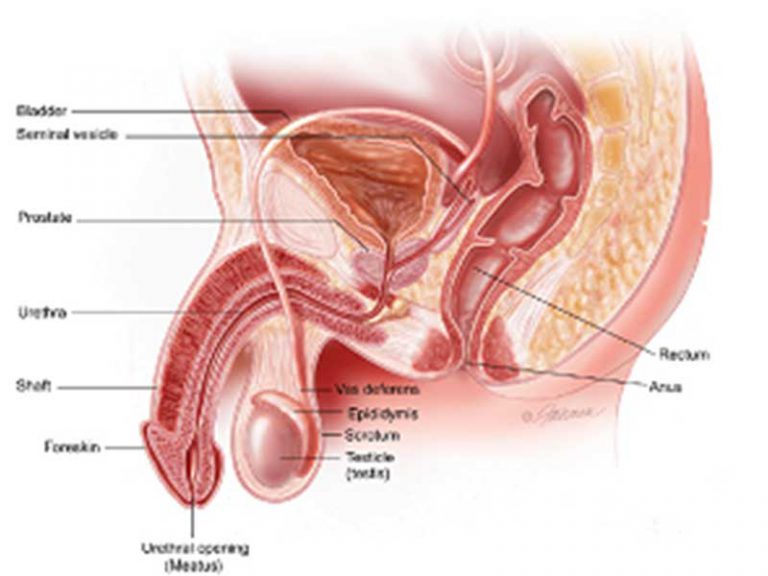
What is Prostate?
Get the facts:
The prostate is a walnut sized gland situated below the bladder. The main job of the prostate is to make substances that give nourishment for Semen.
The prostate surrounds the urethra and when it enlarges it causes blockage to the urethra, causing difficulty in urination. Commonly cancer develops inside the prostate gland which can also spread to other parts of the body.
What Is Prostate Cancer?
Prostate cancer develops due to uncontrolled growth of cells inside the prostate.
This growth is so uncontrolled that it can spread to nearby organs such as bladder or rectum or to other parts of the body. The prostate cancer can be life-threatening if it spreads beyond the prostate. (Metastatic Prostate cancer)
The survival rates of prostate cancer have increased nowadays, thanks to the better testing and treatment options.
Some of the prostate cancers are slow-growing and no treatment is needed for them and others grow very fast and are life threatening.
To make a decision regarding the treatment that’s best for your family or loved ones, can be tough. Consult Dr Ashish Sabharwal today, to help make the right choice for you.
What is the early prostate cancer?
The early prostate cancer is either “localised” or contained within the prostrate or It may be a little bit out of the prostate (Extra- prostatic extension), But it has not spread to other parts of the body.
If the cancer moves to other parts of the body out of the prostate then it is called “advanced” prostate cancer.
Prostate cancer has 4 stages:
- Early-stage/stage l and ll: The tumour has not spread beyond the prostate. This is known as “early stage” or localised prostate cancer
- Locally advanced or stage lll: The cancer has spread only slightly outside the Prostate but only to the adjacent areas. This is known as “locally advanced prostate cancer. “
- Advanced | Stage lV Prostate cancer: Cancer has spread outside the prostrate to other parts of the body such as lymph nodes, bones, spine, liver, lung or brain. This stage is often called “advanced prostate cancer”
What are the risk factors for prostate cancer?
- Age: As men grow old, the chance of having prostate cancer increases. All men after age of 55 should have a prostate cancer testing.
- Ethnicity: Africans and African American men have highest incidence of prostate cancer. One in six black men will be diagnosed with prostate cancer. Prostate cancer occurs less often in Indian population, but whenever it happens in the Indian population it is very aggressive.
- Family history: If you have a grandfather or father or a brother with prostate cancer you have a higher risk of getting prostate cancer. If you have family members having breast cancer or ovarian cancer, that also increases the man’s risk of having prostate cancer.
- Obesity: If you are overweight in your 50s and later there is a greater risk of having advanced prostate cancer. So you should always maintain active lifestyle and stay slim.
- Locally advanced or stage lll: The cancer has spread only slightly outside the Prostate but only to the adjacent areas. This is known as “locally advanced prostate cancer. “
- Advanced | Stage lV Prostate cancer: Cancer has spread outside the prostrate to other parts of the body such as lymph nodes, bones, spine, liver, lung or brain. This stage is often called “advanced prostate cancer”
What are the signs of prostate cancer? Video
In the very early stages, prostate cancer can be asymptomatic.
Some patients may have Urinary symptoms due to the prostate enlargement.
Warning signs are:
- Pelvic pain
- Reduced urine flow or burning in urination
- Blood in urine
- Painful ejaculation
- Pain in the lower back, hips or thighs.
- Loss of weight and appetite
- Bone pain
How to diagnose prostate cancer?
All men who have the following risk factors should do screening for prostate cancer:
- Between 55 to 69 years old
- African or African American
- Family history of prostate cancer
- Have symptoms
The screening is done by a blood test called PSA or prostate specific antigen and a digital rectal exam (DRE) test.
PSA test:
PSA is a blood test which tests the presence of a protein in blood which is produced by the prostate. The normal PSA is less than 4 ng per ML.
Any PSA value higher than 4ng/ml can be a sign of prostate cancer.
Digital rectal exam (DRE) test:
This means putting a finger in the rectum and feeling for the Prostate consistency. If the prostrate feels hard it can be a sign of prostate cancer.
The combination of a PSA test in digital rectal examination can help diagnose prostate cancer early before it has spread to other parts of the body. Treatment of prostate cancer in the early stage may cure the cancer.
Prostate biopsy:
If the PSA is higher than 4 ng/ml or there is a hard nodule felt on the rectal examination, the first step is to do a prostate biopsy for the diagnosis of prostate cancer.
The prostate biopsy test procedure under Transrectal ultrasound guidance. There is minimal prostate biopsy pain. The prostate biopsy report takes 5 days. The common side effects of prostate biopsy are – Bleeding, Infection, and urinary retention.
Imaging and scans
The imaging helps in finding out if the cancer is confined to the prostate it has spread beyond the prostate. The various types of imaging used in prostate cancer are as follows:
- Magnetic resonance imaging MRI: an MRI scan tells about the exact anatomy of the prostate and the surrounding areas. Multi parametric MRI of the prostrate tells if the prostate cancer is confined to the prostate or it has spread into the seminal vesicles or the rectum or invaded the bladder. The MRI is usually done before the biopsy to identify where the lesion in the prostate is and that will help in biopsy. It also helps by telling us the exact anatomy prior to a planned robotic radical prostatectomy. The MRI is done with a contrast dye injected into the Vein just before the scan to see the details. MRI uses magnetic waves instead of x-rays.
- Positron emission tomography (PET) scan: During the scan a special tracer dye called PSMA that is prostate specific membrane antigen, is injected into the veins and then the images are taken from the whole body. Our body cells will pick up the tracer as it passes through the body. The TRACER is only picked up by prostrate cells anywhere in the body. The scanners allows the doctor to see where all the Prostate cancer has spread.
- Bone scan: A bone scan can help to show if the cancer has reached the bones. Prostate cancer usually spreads to the bones first. In bone scan the radio nucleotide dye is injected through the vein and goes to the bones. Cancer spots are highlighted by the dye.
Staging and grading of prostate cancer:
The grading of prostate cancer is done by Gleason’s score. The grading can be Gleason 6 up to Gleason 10. Lower grades are given when samples have small closely packed cells. The Gleason score is sum of the two most common Grades found in a biopsy sample.
The early prostate cancer is divided into low intermediate and high-risk categories based on the Gleason score and PSA (D’Amico classification). This tells about risk of cancer recurrence after primary treatment.
PSA | Gleason score | |
Low risk | <10 | 6 |
Intermediate risk | 10-20 | 7 |
High risk | >20 | 8,9,10 |
What is that staging of prostate cancer?
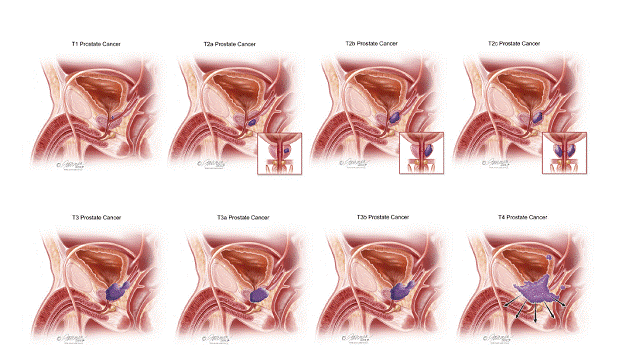
The tumour, nodes and metastasis (TNM) is the system used for Tumour staging.
The TNM score tells us the extent of spread of prostate cancer in the body. The T (Tumor) score tells us the Tumor size and extent. The N (nodes) score tells us whether the cancer has spread into the lymph nodes near to the prostate. The M (metastasis) stage indicates if the cancer has spread to different parts of the body outside the area of the prostate.
The tumour staging (T) for Prostate cancer is as follows:
- T1: Tumour cannot be felt on rectal examination. It is diagnosed either on the biopsy specimen of TURP chips or on Prostate biopsy biopsy done due to high PSA.
- T2: The tumour is confined to the prostate and we can feel the tumour on rectal examination.
- T3: The cancer has begun to spread outside the prostate and we involve the seminal vesicles
- T4: The cancer has spread to the nearby organs like Urinary bladder or rectum.
What is the treatment for early prostate cancer?
The prostate cancer which is confined to the prostate and has not gone beyond the prostate to other parts of the body like the lymph nodes or bones is called early-stage prostate cancer. Early-stage prostate cancer has very good prognosis and high chance of survival. There are various treatment options for early-stage prostate cancer.
The treatment is based on the following considerations:
- The staging and grading of prostate cancer ( The Gleason score and the TNM stage)
- Your risk category ( Whether the cancer is low risk or intermediate risk or high-risk)
- Your age and health
- Your preferences about side effects and long-term effects of treatment
- Your treatment goals
- Results from other diagnostic tests.
When you get to know that you have prostate cancer, think over your wide range of treatment choices. Find out what are the chances of survival with each of the different treatments and also learn about the side-effect profile of each treatment.
Learn about the skill and reputation of doctors available to treat you. There are many general urologists or General oncologists. Dr Ashish Sabharwal is a specialised prostate cancer specialist who did his three year training at University of Miami, USA from 2008 to 2011. Till date, he has done more than 2000 robotic surgeries for prostate cancer, one of the highest volume in the whole of India….And the number of happy patients is growing day by day. Most of his patients have early recovery from surgery with no ICU stay and no need for blood transfusion. Also there is no risk of urinary incontinence or erectile dysfunction, as we do nerve sparing robotic radical prostatectomy. We will be happy to share the phone numbers and contact details of our successfully treated patients so that you can speak to them and know about their experiences.
As soon as one is diagnosed of prostate cancer you should get healthy. With the guidance of the doctor eat a well-balanced diet, Reduce weight if you are overweight, exercise regularly, quit smoking and avoid alcohol. All these healthy habits help you fight prostate cancer!
The treatment options available for early-stage localised prostate cancer are as follows:
- Active surveillance: This is usually done in very small and slow growing low-risk cancers in patients who are either unfit for surgery or they do not want surgery. In this we do not do any treatment for the prostate cancer we just check the patient’s PSA and do prostate biopsy every year. If we see that the PS is rising or the biopsy shows that the cancer is becoming more aggressive then a definitive treatment like surgery or a radiation therapy can be done at a later time.
- Watchful waiting: this is also a form of active surveillance in which we do not do regular PSA and biopsy. It is a way of just ignoring the prostate cancer as we think that the current cancer will not harm the patient as the patient is very old and is likely to die of other causes.
The two main treatments for early stage cancer or surgery and radiation therapy. The goal of both these treatments is to completely cure the prostate cancer.
Robotic Radical Prostatectomy for Prostate Cancer Treatment
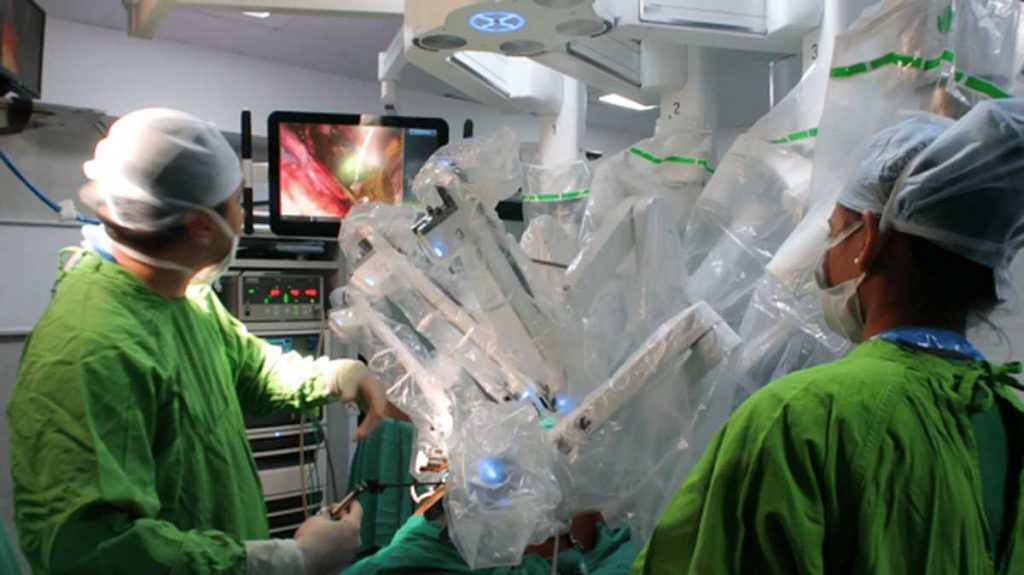
This is the surgical removal of the whole prostate including the seminal vesicles and the surrounding tissues including lymph nodes.
This surgery needs hospital admission for 3 to 4 days and it requires Anaesthesia during the surgery.
In the robotic assisted laparoscopic radical prostatectomy, five very small holes (about 8 mm in size) are made in the lower tummy and through these holes, the robotic instruments and a small camera are inserted, which allows the surgeon to reach up to the Prostate and remove it.
The advantage of robotic surgery is:
- Lesser blood loss
- no need for blood transfusion
- quick recovery
- early discharge from the hospital
- early return to normal activities and work
- 3-D vision during surgery
For full information about robotic surgery watch my youtube video
Radiation therapy (Radiotherapy) for Prostate Cancer Treatment:
Radiation therapy uses high-energy rays to kill cancer cells.
External beam radiotherapy (EBRT): In this type of x-ray the photon beam of radiation is directed from outside of the body into the prostate. A small amount of radiation is delivered in daily doses of the prostate for a total of six weeks. It is outpatient procedure. The patient goes to the radiation centre for five days of the week for a duration of 15 to 20 minutes and gets the EBRT. So it is a session of five days on with two days off and again, five days on and two days for total of six weeks. The advantage of the EVRT is that it limits the radiation to the neighbouring organs like bladder and rectum.
Prostate brachytherapy (Internal radiation therapy): In this type of radiation radioactive material is placed inside the prostate using needles or a tube and Prostate is irradiated from within.
There are two types of Brachytherapy:
- Low dose rate (LDR) Brachytherapy, and
- High Dose rate ( HDR) Brachytherapy
Anaesthesia and hospital stay overnight are needed for both.
For comparison between Radiotherapy and Robotic Radical Prostatectomy for Early stage Prostate Cancer Treatment in New Delhi, India watch my full Video:
The common side effects after radiation are Urinary incontinence, bladder problems and ED. Urinary and bowel problems get better for most men. Erections become worse over a period of two or more years.
Radiotherapy is combined with hormone therapy to shrink the prostate before starting treatment. Hormone therapy is always combined with external beam radiotherapy for two years to make the radiation more effective. The hormone therapy is also called androgen deprivation therapy (ADT). ADT reduces Testosterone levels in the body and thus controls the Prostate cancer.
The major side-effects of hormone therapy for prostate cancer are Loss of libido, ED, hot hot flashes, changes in body fat and emotions.
Hormone therapy for Advanced Stage 4 prostate cancer treatment:
Prostate cancer is a hormone responsive cancer. This means that the growth of prostate cancer is dependent on the male hormone testosterone. We lower the male testosterone levels with the help of hormone therapy.
This is also known as androgen deprivation therapy (ADT).
This treatment slows the growth of prostate cancer so the prostate cancer stays under control to an extent. This therapy does not cure prostate cancer. As long as the hormone therapy is going on the prostate cancer stays under control and PSA stays low, but as soon as the hormone therapy is stopped, the cancer starts growing again and the PSA starts rising.
This therapy is only used for cancer that is metastatic (Spread beyond the prostate), or to control the growth of prostate cancer while he is waiting for surgery.
Hormone therapy can be by surgery or by medicines.
For full information about State IV Prostate Cancer Click Here.
Other considerations:
- Erectile dysfunction (ED) :
ED May happen after prostate cancer treatment for the following reasons:
- Damage to the neurovascular bundle surrounding the prostate
- Emotional stress due to the cancer diagnosis
- Venus leakage after surgery
The chance of suffering from ED after the prostate cancer treatment depends on many things: Age, overall health of the patient, medicines that the patient is taking, sexual function before the treatment, cancer stage, damage to the nerve or blood vessels from surgery or radiation.
There are many treatments that may help ED. These include medicines, vacuum erection devices, and penile injections and penile implant. All these treatments have their advantages and disadvantages so you should talk to us regarding the various options of erectile dysfunction treatment after prostate cancer treatment. For full information on erectile dysfunction after Prostate removal, watch my YouTube video: https://youtu.be/lPLyg3PSAAw
There may be a change in orgasm for men treated with surgery. They do have an orgasm but there is dry ejaculation because the seminal vesicles and the prostrate which produced semen have been removed during surgery. The orgasm will be dry and there will be no Ejaculate.
Urinary incontinence:
There may be some loss of urinary control after prostate cancer surgery or radiation.
The different types of Incontinence are :
- Stress incontinence ( SUI) means urine leaks after coughing, sneezing, laughing or exercising. This is the most common type.
- Urge Incontinence: That means sudden urge to pass urine and having to rush to the bathroom. If you are not able to reach the bathroom on time, the urine might leak.This is also called over active bladder.
- Mixed Incontinence is a combination of both stress and urge incontinence.
We usually remove the catheter after the robotic surgery in 10 days. After catheter removal , there might be some urine leakage and the bladder control is not good. Patients will need to wear a diaper for sometime.
We normally do nerve-sparing robotic radical prostatectomy and with the help of the robotic platform we have 3D vision!so we are able to save the urinary sphincter.
We always start the patients on an extensive program of Kegel exercises and medicines to strengthen the pelvic floor muscles.
So 95% of patients are totally continent and regain full bladder control within six months after robotic surgery.
The urinary incontinence will cause physical as well as emotional disturbances, so it is important to understand how to manage this problem.
The following are the treatment choices for managing the urinary incontinence after prostate cancer treatment:
- Kegel exercises to make the pelvic floor muscles strong and to improve bladder control.
- Lifestyle changes like eating healthy diet, stop smoking, reduce alcohol intake, weight loss and making timed visits to the bathroom.
- Medicines to relax the bladder muscles so that they don’t contract forcefully.
- Neuromuscular electrical stimulation use is a device to strengthen the urinary sphincter.
- Surgery to control the urination includes injecting collagen to tighten the urinary sphincter, Implanting a urethral sphincter to tighten the bladder neck, or an artificial sphincter device.
- Adult diapers may help to stay dry but they do not treat the Incontinence.
- Avoid bladder irritants including caffeine, alcohol and artificial sweeteners
With our extensive programme of pelvic floor muscle exercises, Long term Incontinence lasting more than one year is very rare and happens to less than 2% of all surgical patients.
Lifestyle changes
Diet:
A healthy diet increases the energy levels in the body and also boosts the immunity of the body.
The American Cancer Society advises six healthy habits that prevent prostate cancer:
- Plenty of fruits and green leafy vegetables
- High-fibre diet
- Drinking more tea and coffee
- Avoid fatty foods and Simple sugars
- Avoided red meat, Have more fish
- Avoid processed foods specially processed meats like bacon
Exercise
It is important to be physically active throughout the treatment of prostate cancer. This will improve both physical and emotional health. Regular exercise helps in reducing the weight increasing the muscle and bone strength and helps in managing the side-effects of prostate cancer and its treatment.
Best to exercise at least 30 minutes a day. The exercises should include cardiovascular exercises, aerobics and muscle training.
Pelvic floor exercise (Kegel’s Exercises) may help when being treated for prostate cancer. Patients with Strong pelvic muscles are able to achieve Urinary control earlier on after the surgery. Patients with strong pelvic muscles have lesser side effects of erectile dysfunction and urine Incontinence. Watch my YouTube video to know how to do these exercises:
Emotional stress
After treatment most of the patients are very happy that the cancer is gone. But everybody worries about the cancer coming back. You should understand that prostate cancer is like any other cancer and even after treatment, it requires regular monitoring of PSA. The target PSA after successful prostate cancer treatment of early prostate cancer is less than 0.1 ng per ML. If the PSA rises more than 0.1 ng/ML, then it would be a sign of prostate cancer recurrence and that should be monitored and treated as soon as possible.
Even after the treatment close association with your doctor for follow-up is mandatory.
Some men or upset by the side effects of the treatment. Urinary and erection problems can be quite frustrating. These feelings are normal and will get better what time when the problems improve and also we manage how to deal with these problems.
Whatever you are feeling it is better to discuss the problem with your Doctor, as he will advise you the best treatment for your side effects.
Discuss these problems with your partner, so that you manage the issues as a team. Couples cope better when they approach the cancer treatment and side-effects together.
Questions to ask your doctor
It’s best to talk with your doctor before making a treatment choice. Even if you have done a lot of research on your own, talking with your doctor may help you sort out your thoughts. Here are some questions you might ask when you see your doctor:
- What kind of prostate cancer do I have and how aggressive it is?
- Are there other tests I should have, to understand how advanced my cancer is?
- What are the treatment options for this grade/stage of cancer?
- Which treatment do you recommend for me and why?
- How long should I try a treatment type before we know it works?
- What can I do to manage my symptoms?
- What can I do to manage or prevent treatment side effects?
- What is the average lifespan of people with my grade and stage of cancer?
Why Choose Dr Ashish Sabharwal?
- Best Prostate Cancer Specialist in India
- Fellowship Trained for 3 years in Robotic Radical Prostatectomy for Prostate Cancer Treatment at University of Miami, USA
- Till date 2000 Robotic Radical Prostatectomies till now and counting more….
- Certified proctor for robotic surgery in India by “intuitive surgical, USA” This means if they install any robot in any hospital in the whole of India and surrounding countries, they would call him to train the Urologists in that hospital in robotic surgery.
- He operates at the best hospital in India for Robotic Surgery- Indraprastha Apollo Hospital, New Delhi
Which is the best prostate cancer treatment?
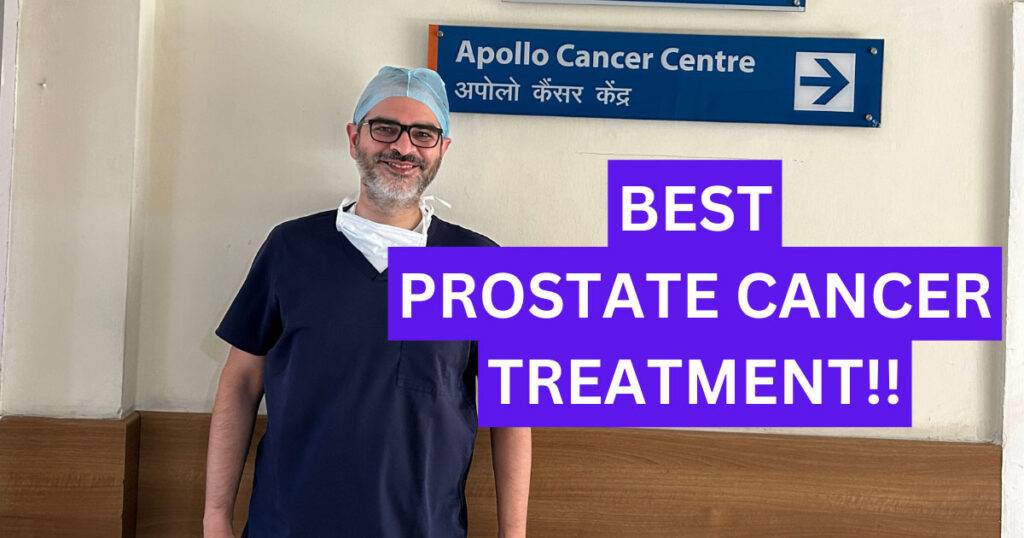
The best treatment for prostate cancer in early stages (stage 1 and 2) is Nerve spearing, robotic radical prostatectomy with Amniotic membrane nerve wrap.
The advantages of Robotic Radical Prostatectomy surgery over radiation are:
1. Exact cancer staging
2. PSA becomes Zero!
3. No need for repeat Biopsy
4. Ease of secondary cancer treatment
5. No prostate enlargement problems in future
6. No risk of secondary cancers
In this article, Dr Ashish Sabharwal explains in detail the advantages of Robotic surgery over radiation. Dr Ashish did his training in Robotic Surgery at university of Miami, USA from 2008 to 2011.After that he returned to India and joined Apollo hospital, New Delhi. He has done more than 2000 robotic surgeries for Prostate Cancer with excellent outcomes. Because of his skills and excellent outcomes, the American company that produces and markets the Da Vinci Robots (intuitive surgical, USA) has made Dr Ashish a certified proctor (trainer and teacher) for Robotic surgery in India..
What is Stage 1 and 2 early stage prostate cancer?
- The first thing which you should know is that only the prostate cancer which is diagnosed at an early stage can be cured. So PSA should be done regularly and we should try to diagnose the prostate cancer at an early stage.
- A Multipara metric MRI and a PSMA PET CT scan should be done to make sure that the cancer is localised.
Surgery Vs. Radiotherapy for Prostate Cancer
Whenever we talk about prostate cancer treatment, the two main treatment modalities for localised prostate cancer are radical prostatectomy surgery and radiotherapy.
What happens during surgery for prostate cancer?
- In radical prostatectomy, we remove the whole prostate including seminal vesicles along with the surrounding tissues i.e. the lymph nodes.
- Radical prostatectomy can be done by open surgery or laparoscopic surgery or Robotic surgery.
- The current gold standard is by using the robotic technology – the Da Vinci Xi Robot.
We do nerve spearing, robotic radical prostatectomy with Amniotic membrane nerve
wrap.
Dehydrated human amniotic membrane nerve wrap (Amchoplast)
The amniotic membrane contains anti-inflammatory factors, stem cells and growth factors. These help to reduce the postsurgical inflammatory response and promote tissue and nerve regeneration. This facilitates the early recovery of urinary control and early return of erections after Robotic Radical Prostatectomy. The addition of this, the Amniotic membrane nerve wrap is one of the latest innovations in treatments of prostate cancer. Its use results in fewer side-effects with rapid recovery after the surgery.
- The whole specimen is removed and sent for histopathology testing.
- Patient stays in the hospital for two to three days and after that he is discharged from the hospital
- He is discharged with Foley catheter, which stays for 7 to 10 days.
- The biopsy report comes in about 10 days.
What happens during Radiation for prostate cancer?
- If the patient chooses for the radiotherapy , the schedule for radiation is as follows:
- It’s given for six weeks with session of five days on and 2 days off, a total of six weeks.
- Patient visits the hospital and stays there for about one hour for the session and then he can go back home. This continues for total of six weeks.
- Along with this patient receives hormone injections for at least 2 to 3 years.
Robotic surgery is the best Prostate Cancer treatment in the world.
It has the following advantages Exact staging after surgery:
- After surgery, Biopsy report comes in 10 days. We know the exact stage and grade of the cancer and also the margin status .So we will know if the cancer has been completely removed and the patient is cancer free.
- In radiation therapy, the prostate cancer is not removed. It is burnt through radiation. Since we are not removing the prostate or sending it for histopathology, we don’t know the exact grade or stage of the cancer and we don’t know if the cancer has been totally cured.
PSA becomes Zero!
- After surgery, since the whole prostate cancer is removed, if the cancer is cured, the PSA becomes zero and that is a great sense of relief and happiness for the patients and their family members.
- After radiotherapy, in the first 2 to 3 years, the PSA keeps on fluctuating and we don’t know if the patient is cured of cancer. So the anxiety levels stay high for 2 to 3 years.
No need of Repeat Biopsy after surgery!
- There is no need of repeat Biopsy after Surgery. The whole Prostate has been removed and so there is no prostate left for Biopsy.
- If PSA fluctuates after radiotherapy, it could be that cancer is not cured and we need to do repeated Biopsy to the Prostate even after radiotherapy. So in any case of rising PSA after radiotherapy, we need to do a repeat biopsy of the prostate. And the patient suffers the associated pain and side effects of repeated biopsy
Another great advantage of the surgery over radiation is the ease of
secondary treatment.
- What this means is that if Cancer comes back after surgery (Rising PSA after surgery or positive surgical margins), it is very easy to give radiotherapy as secondary modality of treatment after the surgery.
- After the radiation, because hormones are going on for two years, we really don’t know if the cancer has been cured by radiotherapy or not. And after two years, when hormone therapy is stopped and the PSA starts rising, then we know that the radiation has not cured the cancer.
- So there is delay in two years in starting treatment and It causes some cancers to progress, so they become from operable to inoperable stage. Also, because of the radiation, the prostate is cemented to the surrounding structures so doing surgery and removing the prostate becomes very difficult and there are many complications and side-effects like rectal injury or bladder injury. There is also a very high risk of Urinary incontinence, so doing surgery after radiotherapy has many problems.
- In short, if you are dealing with cancer and we are thinking that we might need to do a secondary treatment and then it is always better to do surgery first and radiotherapy at a later date. This is because doing radiotherapy after surgery is easy but going for surgery after the radio therapy has many problems.
After surgery, side effects of Prostate Enlargement don’t happen!
- If we do Surgery for Prostate, then the disease of old-age like BPH or Urinary blockage or blood in urine don’t happen in future.
- But if radiotherapy is done, yeah, the prostate is still in the body and later on it might cause Urinary blockage or blood in urine.
Risk of secondary Cancers after Radiation!
- Radiotherapy done in young age, has risk of secondary cancers in urinary bladder in 3 to 5% patients, 20 to 30 years after radiation for prostate cancer.
- There is no such risk after surgery.
Which is the best hospital for Prostate Cancer in India:
Dr Ashish Sabharwal is a prostate cancer specialist in Apollo hospital, New Delhi.
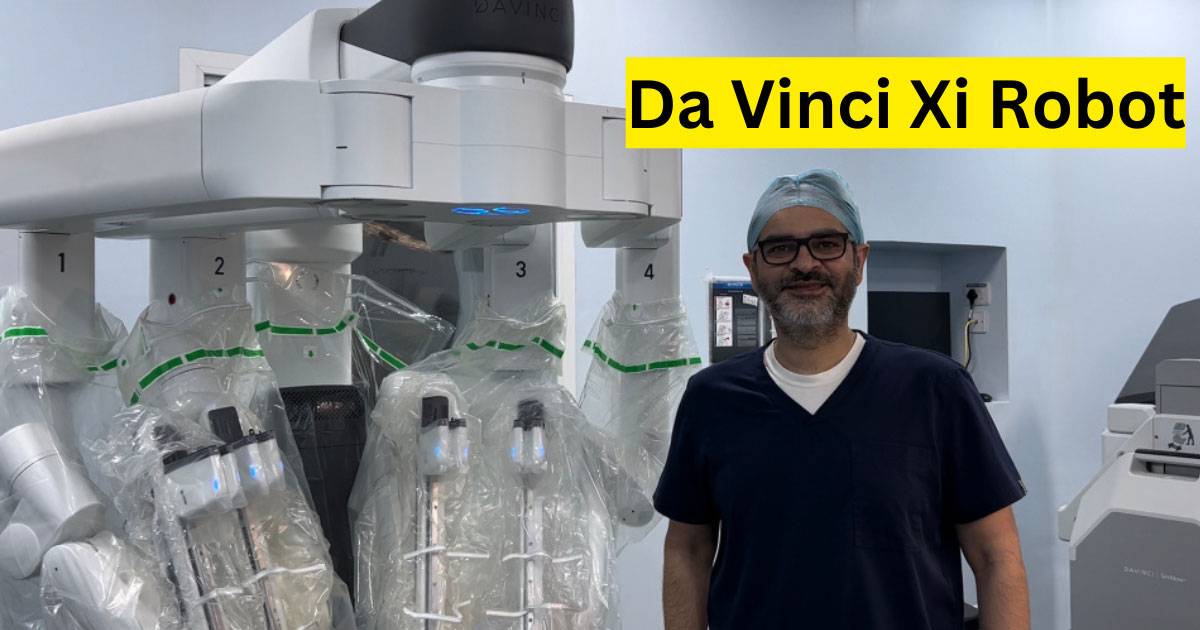
Apollo is the best hospital for Prostate Cancer in India because it has all the latest equipment like Da Vinci Xi Robot for surgery and Radiotherapy (IMRT, IGRT, Proton Therapy, and SBRT) units. It is India’s first international JCI accredited hospital. It’s a multi super speciality hospital with full team of super specialists available. Dr Ashish Sabharwal Uro-oncologist, and other Radiotherapists and Medical oncologists. The hospital has full ICU backup and 24 hour coverage Urology residents. This ensures excellent patient care and treatment results.
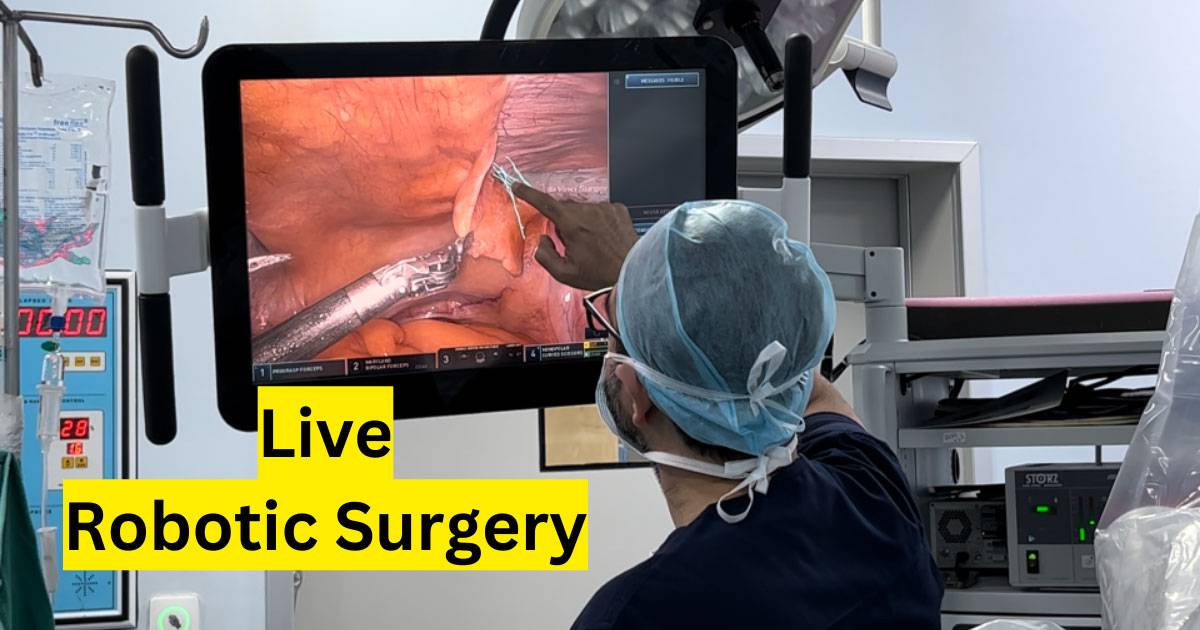
Conclusion
So in this article, we see the comparison of surgery versus Radiotherapy and the many reasons why Nerve spearing, robotic radical prostatectomy with Amniotic membrane nerve wrap is the best prostate cancer treatment for early stage prostate cancer.
If you or your loved ones are also suffering from prostate cancer, and you want to take second opinion, you can contact with Dr Ashish Sabharwal now!

